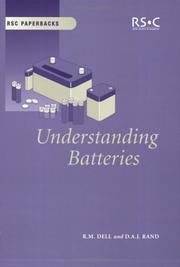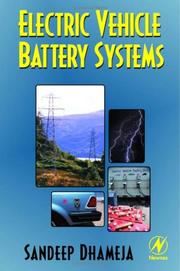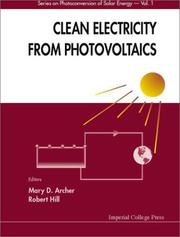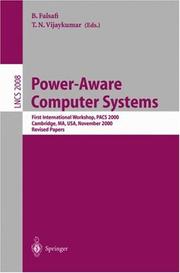| Listing 1 - 8 of 8 |
Sort by
|

ISBN: 0854046054 9781847552228 1847552226 9780854046058 Year: 2001 Publisher: Cambridge : Royal Society of Chemistry,
Abstract | Keywords | Export | Availability | Bookmark
 Loading...
Loading...Choose an application
- Reference Manager
- EndNote
- RefWorks (Direct export to RefWorks)
Batteries are becoming increasingly important in today's world of portable electronic devices, along with the need to store electricity derived from solar and other renewable forms of energy, and the desire to introduce electric and hybrid electric vehicles to reduce emissions. Understanding Batteries is a must for all those seeking a straightforward explanation of how batteries are constructed, their operation, and the factors determining their performance and life. Beginning with a brief history of the development of batteries and a discussion of their applications and markets, the book goes on to outline the basic terminology and science of batteries. The different types of primary (non-rechargeable) and secondary (rechargeable) batteries are then described and emphasis is given to the importance of matching the battery to the intended application. Examples are given to demonstrate how to define and prioritise the various criteria which comprise the battery specification. Throughout, the chemistry is kept as simple as possible. Understanding Batteries will appeal to a wide range of readers, including electrical equipment manufacturers and users, engineers and technicians, chemistry and materials science students, teachers and the interested battery user.
fysicochemie --- Electrical engineering --- Electrochemistry --- Electric batteries. --- Piles électriques. --- Electric batteries --- Batteries, Electric --- Batteries (Electricity) --- Cell, Voltaic --- Electrical batteries --- Electrochemical cells --- Galvanic batteries --- Voltaic cell --- Electric power supplies to apparatus --- Thermopiles

ISBN: 9780444505620 0444505628 9780080543475 0080543472 9786611071073 1281071072 Year: 2001 Publisher: New York Elsevier Science
Abstract | Keywords | Export | Availability | Bookmark
 Loading...
Loading...Choose an application
- Reference Manager
- EndNote
- RefWorks (Direct export to RefWorks)
This book covers all aspects of spent battery collection and recycling. First of all, the legislative and regulatory updates are addressed and the main institutions and programs worldwide are mentioned. An overview of the existing battery systems, of the chemicals used in them and their hazardous properties is made, followed by a survey of the major industrial recycling processes. The safety and efficiency of such processes are stressed. Particular consideration is given to the released emissions, i.e. to the impact on human health and the environment. Methods for the evaluation of this i
Electric batteries --- Storage batteries --- Batteries, Electric --- Batteries (Electricity) --- Cell, Voltaic --- Electrical batteries --- Electrochemical cells --- Galvanic batteries --- Voltaic cell --- Electric power supplies to apparatus --- Electrochemistry --- Thermopiles --- Recycling (Waste, etc.) --- Recycling. --- Environmental aspects.

ISBN: 1281049018 9786611049010 0080488765 0750699167 Year: 2001 Publisher: Boston : Newnes,
Abstract | Keywords | Export | Availability | Bookmark
 Loading...
Loading...Choose an application
- Reference Manager
- EndNote
- RefWorks (Direct export to RefWorks)
Electric Vehicle Battery Systems provides operational theory and design guidance for engineers and technicians working to design and develop efficient electric vehicle (EV) power sources. As Zero Emission Vehicles become a requirement in more areas of the world, the technology required to design and maintain their complex battery systems is needed not only by the vehicle designers, but by those who will provide recharging and maintenance services, as well as utility infrastructure providers. Includes fuel cell and hybrid vehicle applications.Written with cost and efficiency foremost i
Electric automobiles - Batteries. --- Electric automobiles--Batteries. --- Electric automobiles --- Mechanical Engineering --- Engineering & Applied Sciences --- Automotive Engineering --- Batteries --- Batteries. --- Engineering --- General and Others
Book
Year: 2001 Publisher: Washington, D.C : U.S. Dept. of Energy, Office of Advanced Automotive Technologies
Abstract | Keywords | Export | Availability | Bookmark
 Loading...
Loading...Choose an application
- Reference Manager
- EndNote
- RefWorks (Direct export to RefWorks)
Electric batteries --- Electric vehicles --- Technological innovations. --- Research.

ISBN: 1281866032 9786611866037 1601197713 1848161506 9781848161504 1860941613 9781860941610 6611866035 Year: 2001 Publisher: London Imperial College Press
Abstract | Keywords | Export | Availability | Bookmark
 Loading...
Loading...Choose an application
- Reference Manager
- EndNote
- RefWorks (Direct export to RefWorks)
Photovoltaic cells provide clean, reversible electrical power from the sun. Made from semiconductors, they are durable, silent in operation and free of polluting emissions. In this book, experts from all sectors of the PV community - materials scientists, physicists, production engineers, economists and environmentalists - give their critical appraisals of where the technology is now and what its prospects are. Sample Chapter(s)
Chapter 2.1: Introduction (306 KB)
Chapter 2.2: Semiconductor device equations (121 KB)
Chapter 2.3: The p-n junction model of Shockley (1,017 KB)
Photovoltaic cells. --- Photovoltaic power generation. --- Photovoltaic energy conversion --- Photovoltaics --- Direct energy conversion --- Solar energy --- Solar batteries --- Photoelectric cells
Periodical
Abstract | Keywords | Export | Availability | Bookmark
 Loading...
Loading...Choose an application
- Reference Manager
- EndNote
- RefWorks (Direct export to RefWorks)
Fuel cells --- Piles à combustible --- Fuel cells. --- Périodiques. --- Direct energy conversion --- Electric batteries --- Electric power production from chemical action --- Electrochemistry --- Electrical Engineering --- Periodicals.

Abstract | Keywords | Export | Availability | Bookmark
 Loading...
Loading...Choose an application
- Reference Manager
- EndNote
- RefWorks (Direct export to RefWorks)
zonne-energie --- solar power --- Architecture --- Solar physics --- Architecture and solar radiation --- Architecture and solar radiation. --- Photovoltaic power generation --- Photovoltaic power generation. --- Solar buildings --- Solar buildings. --- Solar-heated buildings --- Sun-heated buildings --- Photovoltaic energy conversion --- Photovoltaics --- Solar architecture --- Solar radiation and architecture --- Sun protection in architecture --- Buildings --- Solar heating --- Direct energy conversion --- Solar energy --- Solar batteries --- Solar radiation

ISBN: 3540445722 354042329X Year: 2001 Publisher: Berlin, Heidelberg : Springer Berlin Heidelberg : Imprint: Springer,
Abstract | Keywords | Export | Availability | Bookmark
 Loading...
Loading...Choose an application
- Reference Manager
- EndNote
- RefWorks (Direct export to RefWorks)
The phenomenal increases in computer system performance in recent years have been accompanied by a commensurate increase in power and energy dissipation. The latter has directly resulted in demand for expensive packaging and cooling technology, an increase in product cost, and a decrease in product reliability in all segments of the computing market. Moreover, the higher power/energy dissipation has signi cantly reduced battery life in portable systems. While - stem designers have traditionally relied on circuit-level techniques to reduce - wer/energy, there is a growing need to address power/energy dissipation at all levels of the computer system. We are pleased to welcome you to the proceedings of the Power-Aware C- puter Systems (PACS 2000) workshop. PACS 2000 was the rst workshop in its series and its aim was to bring together experts from academia and industry to address power-/energy-awareness at all levels of computer systems. In these p- ceedings, we bring you several excellent research contributions spanning a wide spectrum of areas in power-aware systems, from application all the way to c- pilers and microarchitecture, and to power/performance estimating models and tools. We have grouped the contributions into the following speci c categories: (1) power-aware microarchitectural/circuit techniques, (2) application/compiler power optimizations, (3) exploiting opportunity for power optimization in - struction scheduling and cache memories, and (4) power/performance models and tools.
Portable computers --- Electric batteries --- Energy conservation --- Electrical Engineering --- Electrical & Computer Engineering --- Engineering & Applied Sciences --- Power supply --- Computers, Portable --- Engineering. --- Computer hardware. --- Computer organization. --- Architecture, Computer. --- Computer programming. --- Programming languages (Electronic computers). --- Electronics. --- Microelectronics. --- Electronics and Microelectronics, Instrumentation. --- Computer System Implementation. --- Computer Systems Organization and Communication Networks. --- Computer Hardware. --- Programming Techniques. --- Programming Languages, Compilers, Interpreters. --- Microcomputers --- Mobile computing --- Computer network architectures. --- Computer science. --- Informatics --- Science --- Architectures, Computer network --- Network architectures, Computer --- Computer architecture --- Electrical engineering --- Physical sciences --- Computer languages --- Computer program languages --- Computer programming languages --- Machine language --- Electronic data processing --- Languages, Artificial --- Computers --- Electronic computer programming --- Electronic digital computers --- Programming (Electronic computers) --- Coding theory --- Organization, Computer --- Architecture, Computer --- Microminiature electronic equipment --- Microminiaturization (Electronics) --- Electronics --- Microtechnology --- Semiconductors --- Miniature electronic equipment --- Programming
| Listing 1 - 8 of 8 |
Sort by
|

 Search
Search Feedback
Feedback About UniCat
About UniCat  Help
Help News
News